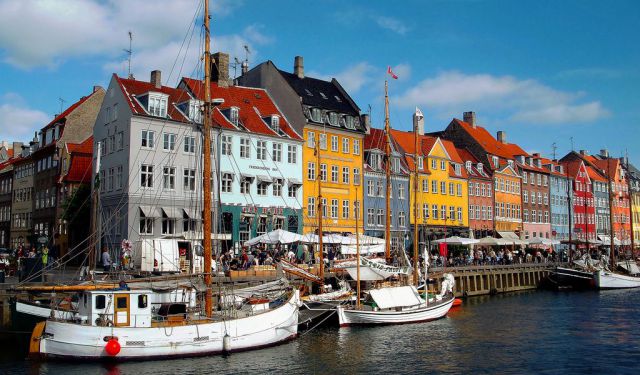
St. Peter's Church (St. Petri Kirke), Copenhagen
Saint Peter's Church, located in the Latin Quarter of Copenhagen, serves as the parish church for the city's German-speaking community. With origins dating back to the 12th century, the church is first documented in 1304 and is considered the oldest building in central Copenhagen. It underwent significant reconstruction following a fire in 1380 and was one of four Catholic parish churches in the city during the Middle Ages.
Post-Reformation, the church was repurposed briefly as a canon and bell foundry before being presented to the German-speaking populace by Frederick II in 1585. Renowned architect Hans van Steenwinckel the Elder renovated the church, adding a gablet upper floor to the initially uncompleted tower. This was later replaced by a spire in the 17th century.
Throughout its history, Saint Peter's Church has been a focal point for Copenhagen's political, economic, cultural, and military elite. The congregation's growth necessitated multiple expansions, including the addition of northern and southern transepts by Christian IV in the 1630s and a further extension by Christian V in the 1690s.
The church features a distinctive complex of sepulchral chapels, started in 1643 and completed by Hans van Steenwinckel the Youngest in the late 17th century. These chapels house numerous tombs and epitaphs of notable German families in Denmark, with sarcophagi and coffins arranged in layers within underground crypts.
Severely damaged in the Copenhagen Fire of 1728, Saint Peter's Church was largely rebuilt by Johan Cornelius Krieger. The interior was redesigned, and a new copper-clad spire was added in 1756-57, which survived the British bombardment during the Battle of Copenhagen in 1807. The church now sports a cruciform layout with significant portions dating back to the mid-15th century. Its main entrance, adorned with a Baroque portal crafted by Diderik Gercken in 1731, and a Rococo-style spire, reflects the architectural evolution and historical significance of this venerable institution.
Post-Reformation, the church was repurposed briefly as a canon and bell foundry before being presented to the German-speaking populace by Frederick II in 1585. Renowned architect Hans van Steenwinckel the Elder renovated the church, adding a gablet upper floor to the initially uncompleted tower. This was later replaced by a spire in the 17th century.
Throughout its history, Saint Peter's Church has been a focal point for Copenhagen's political, economic, cultural, and military elite. The congregation's growth necessitated multiple expansions, including the addition of northern and southern transepts by Christian IV in the 1630s and a further extension by Christian V in the 1690s.
The church features a distinctive complex of sepulchral chapels, started in 1643 and completed by Hans van Steenwinckel the Youngest in the late 17th century. These chapels house numerous tombs and epitaphs of notable German families in Denmark, with sarcophagi and coffins arranged in layers within underground crypts.
Severely damaged in the Copenhagen Fire of 1728, Saint Peter's Church was largely rebuilt by Johan Cornelius Krieger. The interior was redesigned, and a new copper-clad spire was added in 1756-57, which survived the British bombardment during the Battle of Copenhagen in 1807. The church now sports a cruciform layout with significant portions dating back to the mid-15th century. Its main entrance, adorned with a Baroque portal crafted by Diderik Gercken in 1731, and a Rococo-style spire, reflects the architectural evolution and historical significance of this venerable institution.
Want to visit this sight? Check out these Self-Guided Walking Tours in Copenhagen. Alternatively, you can download the mobile app "GPSmyCity: Walks in 1K+ Cities" from Apple App Store or Google Play Store. The app turns your mobile device to a personal tour guide and it works offline, so no data plan is needed when traveling abroad.
St. Peter's Church (St. Petri Kirke) on Map
Sight Name: St. Peter's Church (St. Petri Kirke)
Sight Location: Copenhagen, Denmark (See walking tours in Copenhagen)
Sight Type: Religious
Guide(s) Containing This Sight:
Sight Location: Copenhagen, Denmark (See walking tours in Copenhagen)
Sight Type: Religious
Guide(s) Containing This Sight:
Walking Tours in Copenhagen, Denmark
Create Your Own Walk in Copenhagen
Creating your own self-guided walk in Copenhagen is easy and fun. Choose the city attractions that you want to see and a walk route map will be created just for you. You can even set your hotel as the start point of the walk.
Copenhagen Introduction Walking Tour
The Danish capital Copenhagen is a fairy tale of a city, full of peculiarities. Its name – derived from the Danish words for merchant ("køpmann") and harbor ("havn") – reflects the city's origin as a place of commerce by the sea. A humble fishing village, established in the 10th century AD, some hundred years later it emerged as a town after Bishop Absalon, recognized... view more
Tour Duration: 2 Hour(s)
Travel Distance: 2.7 Km or 1.7 Miles
Tour Duration: 2 Hour(s)
Travel Distance: 2.7 Km or 1.7 Miles
Castle Island (Slotsholmen) Walking Tour
Traditionally seen as the birthplace of Copenhagen, Castle Island (Slotsholmen) gave rise to the Danish capital with a small fortress built on it in the 12th century AD. Since the Middle Ages, this area, also known as the "Island of Power," has been the center of Denmark's government. It houses several prominent landmarks that played significant roles in the country's history.
... view more
Tour Duration: 1 Hour(s)
Travel Distance: 1.6 Km or 1 Miles
... view more
Tour Duration: 1 Hour(s)
Travel Distance: 1.6 Km or 1 Miles
Hans Christian Andersen's Copenhagen
Before Disney glamorized fairy tales, Hans Christian Andersen was the original master of childhood magic. Best known for stories like The Little Mermaid, The Ugly Duckling, The Emperor’s New Clothes, and Thumbelina, Andersen essentially built the foundation of fairy-tale literature—dark undertones and all...
Born in 1805 in Odense, in the middle of the country, Andersen grew up in poverty,... view more
Tour Duration: 2 Hour(s)
Travel Distance: 2.9 Km or 1.8 Miles
Born in 1805 in Odense, in the middle of the country, Andersen grew up in poverty,... view more
Tour Duration: 2 Hour(s)
Travel Distance: 2.9 Km or 1.8 Miles
Little Mermaid Walking Tour
Back in the 18th century, Denmark was in the throes of an economic boom. Constructed during the reign of King Frederick V (hence the name), the district of Frederiksstaden attests to that with its beautiful architecture, measuring up to the projects from the same period in Berlin, Paris, and Vienna. This tour will guide you through the area's broad streets lined by bourgeois houses, mansions,... view more
Tour Duration: 2 Hour(s)
Travel Distance: 2.8 Km or 1.7 Miles
Tour Duration: 2 Hour(s)
Travel Distance: 2.8 Km or 1.7 Miles
Latin Quarter Walking Tour
One of the most interesting, young-spirited neighborhoods of Denmark's capital, the Latin Quarter is well known for its hangout spots, alternative shopping, and 18th-century architecture.
Back in the Middle Ages, the area surrounding Our Lady's Square (“Frue Plads” in Danish), right in the heart of it, was considered a “ray of light” in the overall darkness of those times. A... view more
Tour Duration: 1 Hour(s)
Travel Distance: 1.7 Km or 1.1 Miles
Back in the Middle Ages, the area surrounding Our Lady's Square (“Frue Plads” in Danish), right in the heart of it, was considered a “ray of light” in the overall darkness of those times. A... view more
Tour Duration: 1 Hour(s)
Travel Distance: 1.7 Km or 1.1 Miles
Useful Travel Guides for Planning Your Trip
Copenhagen Shopping: 16 Distinctively Denmark Things to Buy
Denmark is renowned for simple, industrial and functional design, as well as bohemian and everyday fashion-wear for the individual urban living. The capital Copenhagen, home to Copenhagen Fashion Week twice a year and biannual INDEX: Design to Improve Life - the world’s biggest design awards, is...






